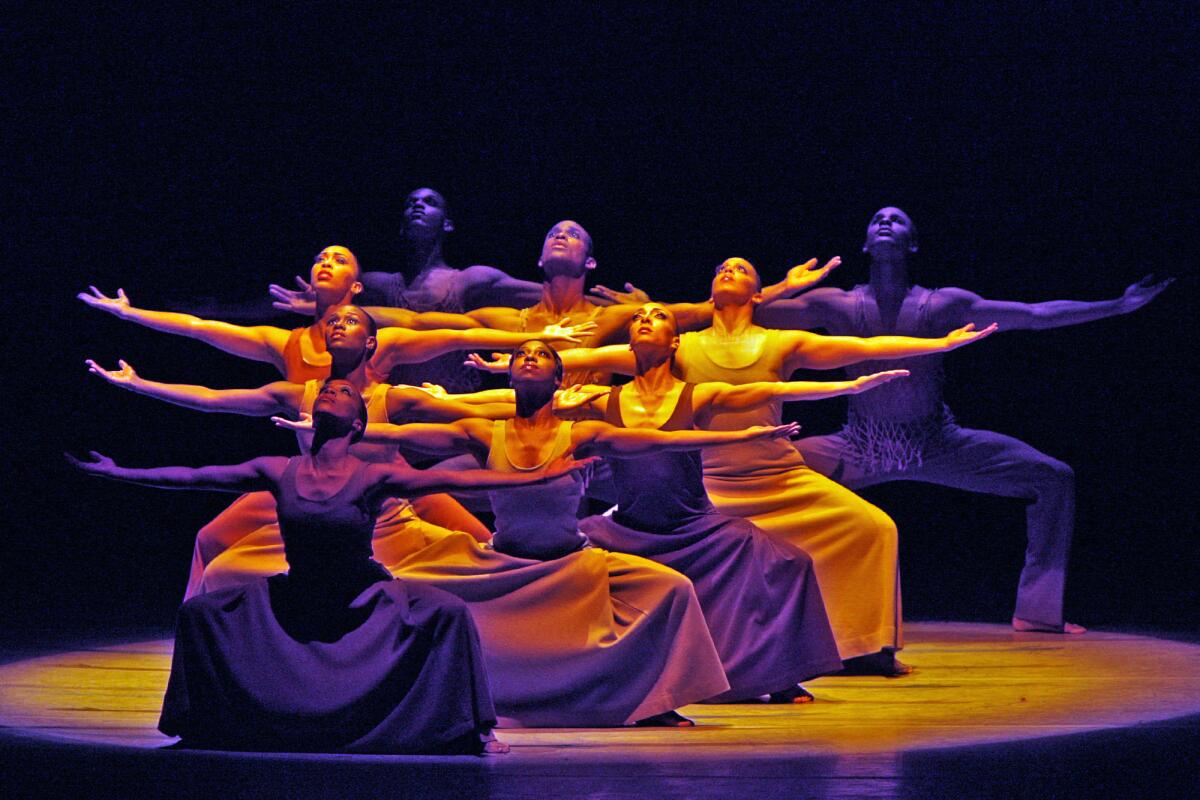What makes Alvin Ailey’s ‘Revelations’ an American dance classic?

- Share via
“A classic is a survivor. A classic transcends the winds of change. We see its genius in the timelessness of its appeal. … There is a measure of comfort in our belief that a classic will resist its age. A classic has nothing to do with truth, but it has something to do with wisdom.”
These words were spoken recently by Chicago radio host Lin Brehmer and it’s an apt definition of what has stood the test of time in culture.
The Alvin Ailey American Dance Theater returned to Chicago for the 47th time recently after appearing earlier in the month at the Los Angeles Music Center. The company’s annual appearance is a Chicago dance tradition, if we ever had one, and a testament to the importance of this predominantly African American contemporary dance company.
Closing every show is Alvin Ailey’s masterpiece “Revelations,” which, coincidentally, premiered 47 years ago too.
Choreographed on the brink of the civil rights movement in America, “Revelations” was a radical act for its time. Today “Revelations” is a history lesson through dance that evades antiquity, a timeless reminder of how far we’ve come, and how far we have to go.
Technically demanding, choreographically sound and aesthetically magnificent, “Revelations” is the dance version of Rodin’s “The Thinker,” or Leonardo da Vinci’s “Mona Lisa.” It’s the closest we get in dance to a permanent exhibit. It’s a classic. And while I often start to complain seeing the same work twice in a season, like most classics, I can (and do) watch this over and over and over, without fatigue.
“I never get tired of doing ‘Revelations,’ ” dancer Solomon Dumas said in an interview. At 28, the Chicago native performed at home for the first time since joining the main company. He first glimpsed the iconic work 15 years ago and has since watched or danced it a few hundred times.
“I was immediately able to connect with the piece,” said Dumas, who recalled renting videos of the company from Chicago’s Harold Washington Library and learning parts of the piece during AileyCamp, an outreach program that introduces dance to inner-city kids. “It’s a period piece,” he said, “but it’s timeless. For me, performing [‘Revelations’] is a spiritual experience.”
In her 17 years with the company, dancer Hope Boykin has performed “Revelations” thousands of times. “I believe in all of what ‘Revelations’ stands for,” she said in a phone interview.
“Mr. Ailey was honest enough to let the work come through him … and it’s my duty to uphold that work. I’m not perfect, but I’m striving to be all of those things I hear every night,” said Boykin, referring to familiar gospel hymns like “Fix Me, Jesus” and “Didn’t My Lord Deliver Daniel” that accompany the dance. “This work is still so relevant,” she said. “Audiences are so moved by this work. … It has changed people.”
Artistic director Robert Battle recognizes the delicate balance between legacy and currency in running a company that is approaching its 60th anniversary. Battle said he’s broadened the company’s repertory during his tenure to incorporate works outside Ailey’s typical aesthetic (adopting works like Ohad Naharin’s “Minus 16” and Christopher Wheeldon’s “After the Rain”).
He’s learning to get “beyond the awe of the responsibility” as the director of a company that has changed hands only twice — founder Ailey hand-picked Judith Jamison to run the company prior to his death in 1989, and Jamison picked Battle when she stepped down in 2011.
“It’s getting more and more comfortable all the time,” said Battle, but he admitted it took some time to find his voice and learn to trust his instincts.
Joining “Revelations” across three unique lineups during the five-day Chicago engagement was “Masekela Language” (1969), a lesser-known Ailey work that draws connections between the South African apartheid and the Chicago race riots of the 1960s, plus two new dances also focused on the African American experience: the first installment of Kyle Abraham’s three-part “Untitled America” and Boykin’s “r-Evolution, Dream.” Abraham’s “Untitled America” examines the criminal justice system and the effects of incarceration on African American families, while Boykin’s “r-Evolution, Dream,” her third piece of choreography for the company, was inspired by recordings of the Rev. Martin Luther King Jr.
Battle will likely continue to move Ailey forward, but now or in the future, he may never get away with ending a show without “Revelations.”
I put a poll out on Facebook, asking why “Revelations” still matters, and the resounding theme across a few dozen responses was, “It just does.” “Revelations” represents more than the Ailey dance company. It represents the faith, beauty and complexity of African American culture. It imbues pain, and humanity and joy. And, for some, it is the best possible representation of how Dance (capital “D”) can bring people together.
“Alvin Ailey wanted dance to be accessible,” said Battle. “People find relief in being together and attending the theater, and dance is nonpolarizing. It’s abstract enough that [viewers are] not being bombarded, and they can decide what that means to them.”
Lauren Warnecke is a freelance critic.
More to Read
The biggest entertainment stories
Get our big stories about Hollywood, film, television, music, arts, culture and more right in your inbox as soon as they publish.
You may occasionally receive promotional content from the Los Angeles Times.










